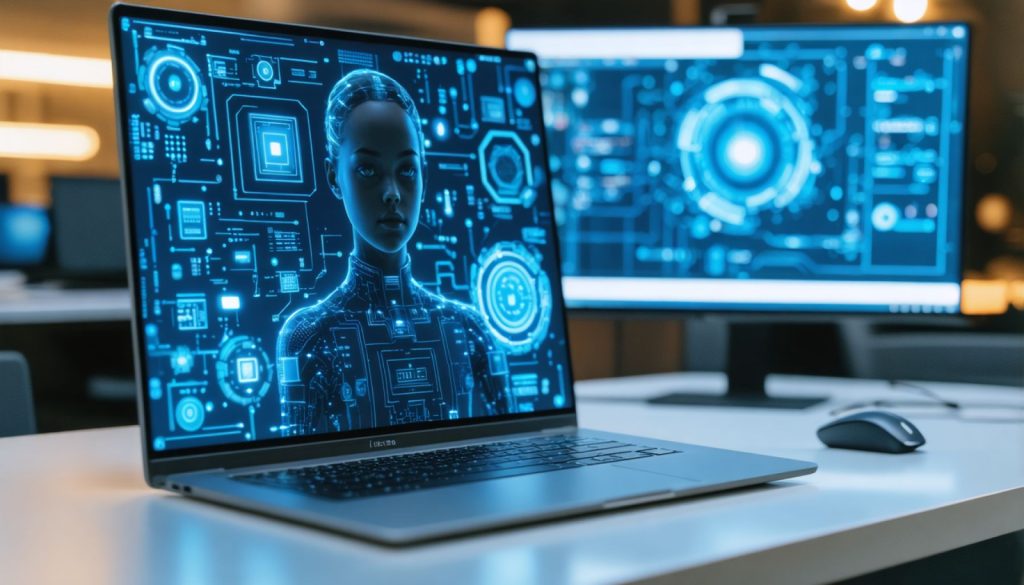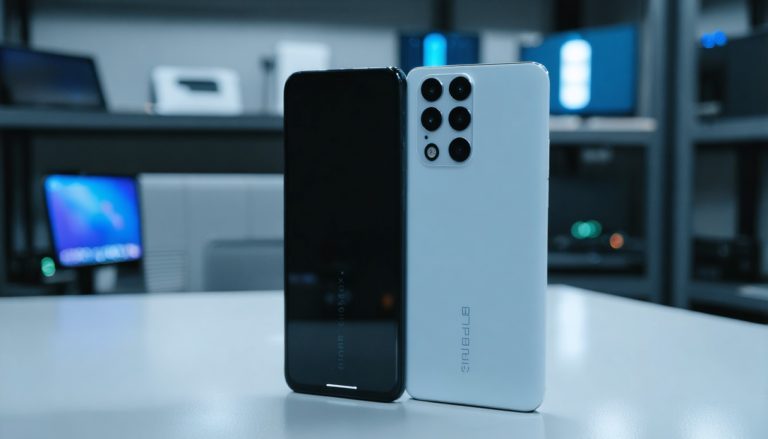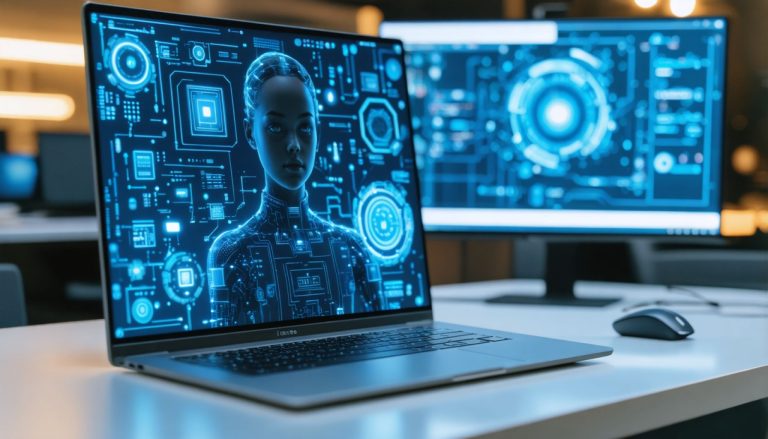
- Artificial Intelligence (AI) is revolutionizing smartphones and personal computers, enhancing their functionalities and user interfaces.
- Next-gen AI devices with advanced system-on-a-chip (SoC) architectures perform up to thirty trillion operations per second.
- Projected growth for the AI device sector is 35.22% through 2031, driven by demand for improved user experiences and connectivity.
- Innovations extend to sectors like multimedia content creation and voice recognition, once thought to be science fiction.
- Data privacy and security concerns challenge the industry as devices handle extensive personal data.
- North America leads the AI revolution, with the Asia Pacific region emerging due to government initiatives and digital infrastructure growth.
- Companies like Microsoft, Apple, and Samsung are incorporating advanced AI features, driving competition in technology advancement.
- AI’s integration into everyday devices signifies a transformative era of connectivity.
A seismic shift underpins the landscape of technology as Artificial Intelligence (AI) profoundly redefines our day-to-day devices. Embodying this revolution are the next-generation AI smartphones and personal computers (AI PCs), whose intuitive capabilities are swiftly pushing boundaries and reshaping our digital lives.
Picture smartphones and PCs with system-on-a-chip (SoC) architectures engineered with neural processing units capable of executing an astounding thirty trillion operations per second. These are not futuristic fantasies, but rather the dawning reality of GenAI smartphones and AI PCs — devices that promise to redefine innovation. They primarily thrive on the symbiosis of enhanced computational brilliance, intuitive user interfaces, and a vastly expanded repertoire of functionalities.
Fueled by relentless demand for enhanced user experiences and seamless connectivity, this flourishing sector expects a remarkable growth rate of 35.22% through 2031. The journey from stagnant to state-of-the-art is not just about speed; it’s about the transformational potential to remake sectors like multimedia content creation and voice recognition, offering capabilities previously confined to science fiction.
However, with sweeping advancements come challenges echoing Plato’s ancient caution — the temple of progress harbors shadows of concern. Data privacy and personal information security cast long shadows over this burgeoning industry. As AI-enabled devices process vast caches of personal data, consumers grow skeptical about the potential risks arising from their digital footprints. Industry leaders are called to navigate this delicate terrain, reassuring the public while pushing technological frontiers.
Dominating the compass of this revolution is North America, buoyed by its hallmark technological ecosystem and demand-driven consumer base. Meanwhile, the Asia Pacific region emerges as an energetic contender, propelled by governmental initiatives and escalated pursuits in digital infrastructure. Here, the smartphone ecosystem swells, fueled by a fusion of cultural adaptation and technological assimilation.
Meanwhile, heavyweight titans like Microsoft and Apple are galloping ahead, embedding state-of-the-art AI features into operating systems to maintain an edge in this technological derby. Not to be outmaneuvered, Samsung has equipped itself for enterprise conquest with its rugged yet refined Galaxy XCover7.
This global narrative of digital metamorphosis serves as a clarion call: We are at the threshold of a new era of connectivity where AI doesn’t just augment—it transfigures. As we embrace the tantalizing allure of GenAI smartphones and AI PCs, the message is unambiguous: the universe of computing will never be the same again.
The Future of AI-Driven Devices: Unveiling the Next Generation of Smartphones and PCs
Introduction to the AI Revolution in Technology
Welcome to an era where Artificial Intelligence (AI) is not merely an accessory but a core element transforming our digital world. AI-driven smartphones and personal computers (AI PCs) are emerging as game-changers, set to redefine user interactions and device capabilities dramatically. With neural processing units in system-on-a-chip architectures capable of executing up to 30 trillion operations per second, the future is here, and it’s incredibly exciting.
Expanding the Horizons: Features and Capabilities
– Machine Learning and Personalization: AI smartphones and PCs excel in learning user behavior and preferences, offering more personalized recommendations and automating mundane tasks. For example, AI can optimize battery usage by predicting app preferences and usage patterns.
– Enhanced Multimedia Creation: These devices are revolutionizing video and audio content creation, providing capabilities like real-time video enhancements, auto-editing features, and sophisticated voice modulation.
– Advanced Voice Recognition: With AI, voice assistants are becoming more intuitive and accurate, handling complex commands and providing more conversational interactions. This improves accessibility for users with disabilities and enhances multitasking efficiency.
The Economic Impact: Market Forecast and Industry Trends
The AI smartphone and PC market is on a trajectory for immense growth, anticipated to balloon at a compound annual growth rate of 35.22% by 2031. As demand for smarter, more efficient, and reliable devices increases, this market is poised to be a significant contributor to the global economy. Regions such as North America spearhead this growth thanks to their tech-savvy consumer bases and robust technological ecosystems, but the Asia Pacific region is quickly catching up with governmental support and expanding digital infrastructure.
Addressing Pressing Questions: Security and Privacy Concerns
One angle that requires careful attention is the privacy and security of personal data. AI devices process large volumes of user data, which raises significant privacy concerns. To mitigate this:
– Transparent Data Policies: Companies need to innovate with transparency by employing robust data protection measures and clear privacy policies.
– On-Device Processing: Emphasizing on-device processing over cloud-based operations can significantly reduce the risk of data breaches.
Industry Contenders: The Competitive Landscape
Major tech giants are leading the charge:
– Apple’s iOS Advancements: Apple continues to integrate AI deeply with iOS, enhancing Siri and machine learning capabilities.
– Microsoft’s AI Integration: Windows-based PCs are embedding AI to offer smarter productivity features and enhanced security measures.
– Samsung’s Enterprise Focus: With devices like the Galaxy XCover7, Samsung caters to the need for robust, enterprise-ready smartphones.
Practical Recommendations for Consumers
– Staying Updated: Ensure your devices run the latest software updates to benefit from enhanced AI features and improved security.
– Exploring AI Features: Familiarize yourself with new AI functionalities in your devices to maximize productivity and entertainment value.
– Smart Usage: Utilize AI-driven battery optimization features to extend battery life and maintain peak device performance.
Conclusion: Embracing the AI-Driven Future
As technology continues its rapid evolution, the integration of AI in everyday devices symbolizes a new frontier of computational excellence and user experience enhancement. The journey promises not only to broaden our horizons but also to present exciting opportunities for personalization, efficiency, and innovation.
For more insights into the tech ecosystem, visit Apple and Microsoft.
Embrace AI, and be prepared to explore unparalleled dimensions of connectivity and interactivity.



